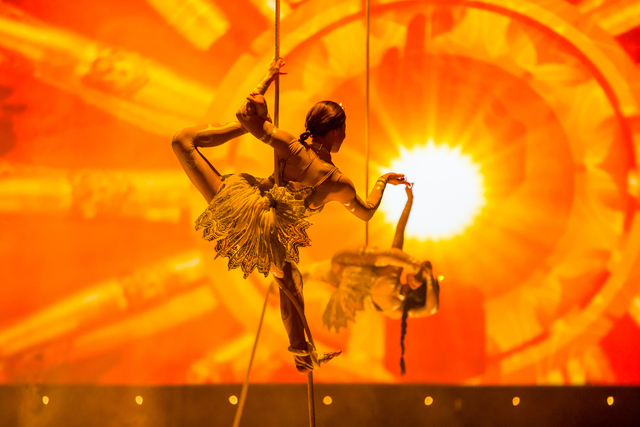‘Love’ embraces youth movement without losing heart

The Beatles ran for nine years, but the surviving members still don’t have to worry about people getting tired of them.
Cirque du Soleil’s “Love” has run for 10 years, but its creators can’t be so complacent. Cirque gave one of its most popular Las Vegas titles a makeover, adding more dance, brighter colors, new video and even a couple of switched-out songs.
Fans will have different opinions on whether the big picture has changed for the better, worse or imperceptibly. But it seems there’s one thing no one has to worry about: screwing it up.
Some of Cirque’s Las Vegas titles took a long time to get there (“Zumanity”). Others seemed redundant (“Zarkana”) and some just never worked at all (“Viva Elvis”). But “Love” was exhilarating right out of the gate, and it’s even more clear now that the magnetic bond — Cirque’s acrobatics and the Beatles mixed out in the glorious sound of 7,000 speakers — is so strong that continued tinkering just plays like variations on a theme.
(Literally, given music supervisor Giles Martin’s ability to keep cutting and pasting the song catalog and studio outtakes in endless combinations. After all, he calls himself @mashupmartin on Twitter.)
Truth be told, I was a bit worried that bringing in Napoleon and Tabitha D’Umo — the choreographers from “So You Think You Can Dance” and the Jennifer Lopez’s “All I Have” — signaled pressure from Cirque’s new private equity partners to make “Love” another “Michael Jackson One,” and lose the wistful, European tone that tied the Beatles show to the pioneering “Mystere” and “O.”
You do get more “pop art” with sexy young people, and less of Sgt. Pepper and Father McKenzie shuffling around with the surreal citizens of post-war Liverpool. But director Dominic Champagne maintains a delicate balance. The opening still takes us from the jubilant “Get Back” to a symbolic World War II air raid, leaving “all the lonely people” to dig themselves out of the rubble.
When a Volkswagen Beetle rolls in to the strains of “Twist and Shout,” and unbridled youth erupt in floor acrobatics for “I Want to Hold Your Hand,” you get the sense of a cultural movement even bigger than its soundtrack.
You’d have to be a loyal repeat customer to notice every little change, but some stand out. First, the Beatles themselves show up, thanks to the group’s business entity giving the nod to use video as well as audio. Now we see Paul McCartney singing “Yesterday” during a couple’s aerial ballet.
Enhanced digital video on moving panels also lets us see more of the four Mop Tops, who almost become 3-D cartoon characters on the in-the-round stage. Video mapping makes the stage floor a projection surface as well, adding new dimensions to the yellow gumboot dance by Michael Moloi Tumelo that sets up “Lady Madonna.”
The closest thing to the type of generational rift the Beatles created (one mocking sound snippet decries “the moral decay of our blood, our class, our glorious empire”) is how you will feel about the newly animated video version of “While My Guitar Gently Weeps.”
I thought the simplicity of the older version, with the focus solely on the human dancer (now Eira Glover), spoke eloquently of loss and mourning. Those who grew up on video games and computer animation may prefer the more dazzling and literal presence of the lost one.
The fact that the Beatles, and this show, can still have people of different ages lay claim to “their” version speaks to the enduring power of both.
Read more from Mike Weatherford at reviewjournal.com. Contact him at mweatherford@reviewjournal.com. Follow him @Mikeweatherford.